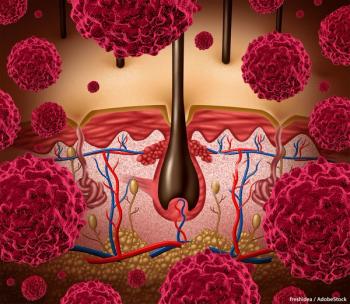
Rule of 3 Proposed for Melanoma Genetic Testing in Countries With Lower Incidence
In France and other countries with low to moderate incidence of melanoma, a new study has proposed recommending genetic testing using the rule of 3-screening those with 3 or more primary melanomas or genetically related cancers-instead of the rule of 2.
In France and other countries with low to moderate incidence of melanoma, a new study
Results of their study showed that the mutation rate for high- or intermediate-risk melanoma susceptibility genes increased from an incidence of 6.5% to 9.3% when applying a rule of 3 instead of a rule of 2.
“On the basis of these data, obtained in general population testing conditions and not in the setting of early precise genetic research studies designed to discover melanoma-prone mutations, we recommend moving toward the use of the rule of 3 in France,” wrote Juliette Delaunay, MD, Service de Dermatologie Centre Hospitalier, Lyon-Sud, France, and colleagues.
According to the study, guideline established by the American Society of Clinical Oncology set a threshold of 10% positivity to justify BRCA1 testing in patients with breast cancer. Afterwards, this cutoff was used widely to set a minimal cost-efficiency in cancer genetic testing. Currently in France, genetic testing for melanoma is proposed in cases with 2 cutaneous melanomas and/or related cancers in the same patient, or in first- or second-degree relatives-called the rule of 2.
In this study, Delaunay and colleagues conducted a retrospective analysis of 1,032 patients who underwent genetic testing for melanoma from 2004 to 2015. They measured for the frequency of mutation in high and intermediate susceptibility genes.
When applying the rule of 2, the mutation rate was 67 of 1,032, or 6.5%. The rate of mutations increased to 38 of 408 patients, or 9.3%, when applying the rule of 3 instead (P = .68), and increased further to 27 of 150, or 18%, when applying a rule of 4.
The researchers made an exception to this recommendations in families and patients with a first melanoma occurring before age 40. The effect of age at first melanoma was observed in those patients aged younger than 40, where the mutation rate was 32 of 263, or 12.1% (P = .12), for the rule of 2 and 22 of 121, or 18.2% (P = .001), for the rule of 3.
Applying the rule of 2 compared with the rule of 3 in patients aged younger than 40 also reduced the number of missed CDKN2A-mutated families from 14 of 43 to 7 of 43.
“This finding could lead to recommend pursuing the indication of the rule of 2 in these cases,” the researchers wrote. “Moreover, knowing the high penetrance of CDKN2A mutation, we can assume that these families could be detected later, after occurrence of a third event, which is likely to occur.”
Newsletter
Stay up to date on recent advances in the multidisciplinary approach to cancer.
















































































